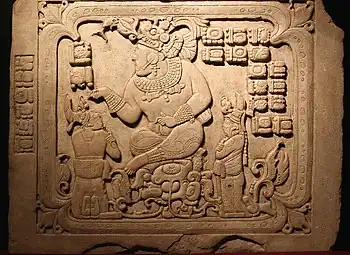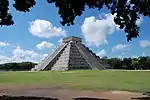
Cancuén is an archaeological site of the pre-Columbian Maya civilization, located in the Pasión subregion of the central Maya lowlands in the present-day Guatemalan Department of Petén. The city is notable for having one of the largest palaces in the Maya world.
Ancient Cancuén
Cancuén was a major city during the Classic Period, reaching its peak during the 7th century. The city was a major trade center, specializing in jade, pyrite and obsidian. Its strategic position on the river Pasion helped it dominate trade in the region. Tajal Chan Ahk, one of the city's most powerful rulers, built the city's palace in 770 A.D. The palace covered nearly 23,000 square meters and contained 200 rooms, making it the largest in the Maya area. The city had two ball courts, a large marketplace and a dock on La Pasión River. The city does not contain many large temples or burial sites; it is thought that the inhabitants of Cancuén worshipped and buried their dead in the mountains near the city.
Massacre around 800 A.D.
Several dozen bodies dressed in royal garments were discovered near the base of the central pyramid. Investigations have shown that the bodies, including the city's ruler at the time, Kan Maax, had been executed and dumped in a cistern.[1] The massacre occurred around 800 A.D.,[1] the time when the Mayan civilization collapsed, leading some scholars to believe that it was connected to the upheaval that accompanied the collapse of the Maya civilization.
Abandonment of Cancuén
Cancuén is thought to have been abandoned shortly after the massacre event around 800 A.D., and was subsequently not re-occupied.[2]
Excavation
The site was rediscovered in 1905 by Austrian explorer Teoberto Maler. No major temples or burial sites were reported in the initial investigations, leading archaeologists to believe it had been a minor or subsidiary site. Cancuén was largely ignored until 1967, when students from Harvard University uncovered the ruins of the largest Palace in the Maya world. Its walls are up to 1.8m thick and, with more than 200 rooms and 12 patios, it has more than 200,000-square-foot (19,000 m2). Further investigations showed that the size of the structure and the entire site had previously been underestimated; it is now thought that a "maze of hundreds of rooms with 20-foot-high, arched ceilings" covered at least 3 square miles (7.8 km2).[3] Subsequent archaeological expeditions were launched following the discovery of the palace, including teams from Vanderbilt University and the Universidad del Valle de Guatemala. The National Geographic Society is also connected to the excavations.
Known persons
| Name | Notes |
|---|---|
| K'inich K'ap K'ayal Ahk | Ruler who died in 653 |
| K'iib' Ajaw | Ruler who ascended in 656 |
| Chan Ahk Wi' Taak Chay | Ruler who ascended in 677 |
| GI-K'awiil | Wife of the king Ucha'an K'in B'alam of Dos Pilas |
| Tajal Chan Ahk | King who ruled 757 - c. 799 |
| Kan Maax | Last ruler of Cancuén |
See also
Notes
- 1 2 Vergano, Dan (2005-11-17). "Royal Mayan massacre". USA Today.
- ↑ Jackson, Sarah (2005). Deciphering Classic Maya Political Hierarchy: Epigraphic, Archaeological, and Ethno-Historic Perspectives on the Courtly Elite (PhD dissertation). Harvard University. ProQuest 3173932.
- ↑ Bower, B. (September 16, 2000). "Maya Palace Suddenly Expands". Science News. Vol. 158, no. 12. p. 184.
References
- Barrientos Quezada, Tomás (2007a). "Cancuén: Punto estratégico para el comercio entre las Tierras Bajas y el Altiplano Maya durante el Período Clásico". Interrelaciones Culturales de los diferentes grupos étnicos que habitaron en el área Centramericana. II Congreso Centroamericano de Arqueología en El Salvador, 23–27 October 2007 (in Spanish). San Salvador: Consejo Nacional para la Cultura y el Arte (CONACULTURA), Museo Nacional de Antropología "Dr. David J. Guzmán" (MUNA), Ministerio de Turismo (MITUR), Asociación Amigos del MUNA (AAMUNA), Fundación Nacional de Arqueología en El Salvador (FUNDAR). Archived from the original (DOC online publication) on 25 July 2011. Retrieved 2008-03-03.
- Barrientos Quezada, Tomás (2008). "Hydraulic Systems in Central Cancuén: Ritual, Reservoir, and/or Drainage?" (PDF online publication, translation from Spanish by Eduardo Williams). The Foundation Granting Department: Reports Submitted to FAMSI. Foundation for the Advancement of Mesoamerican Studies, Inc. (FAMSI). Retrieved 2008-03-03.
- Demarest, Arthur A. (2006). The Petexbatun Regional Archaeological Project: A Multidisciplinary Study of the Maya Collapse. Vanderbilt Institute of Mesoamerican Archaeology series, vol. 1. Nashville, TN: Vanderbilt University Press. ISBN 978-0-8265-1520-9. OCLC 63178772.
- Kistler, A. (2004). "The Search for Five-Flower Mountain: Re-evaluating the Cancuen Panel" (PDF). Mesoweb articles. Mesoweb: An Exploration of Mesoamerican Cultures. Retrieved 23 February 2023.
- Mathews, Peter; Gordon R. Willey (1991). "Prehistoric polities of the Pasion region: hieroglyphic texts and their archaeological settings". In T. Patrick Culbert (ed.). Classic Maya Political History: Hieroglyphic and Archaeological Evidence. School of American Research advanced seminar series. Cambridge: Cambridge University Press. pp. 30–71. ISBN 0-521-39210-1. OCLC 20931118.
- Moran, Melanie; Mimi Koumenalis (2005-11-18). "Royal massacre signals the beginning of the end of the Maya empire". Exploration: Vanderbilt's Online Research Magazine. Nashville, TN: Vanderbilt University. Archived from the original on 2008-03-06. Retrieved 2008-03-03.
- Salisbury, David (2003-11-07). "Ancient Maya stone altar recovered in Guatemala" (PDF). Exploration: Vanderbilt's Online Research Magazine. Nashville, TN: Vanderbilt University. Archived from the original (PDF) on 2006-09-02. Retrieved 2008-03-03.
- Salisbury, David (2004-05-07). "How Maya kings played ball". Exploration: Vanderbilt's Online Research Magazine. Nashville, TN: Vanderbilt University. Archived from the original on 2008-08-21. Retrieved 2008-03-03.
- Skidmore, Joel (2005-11-19). "Cancuen in the News". Mesoweb Reports and News. Mesoweb. Retrieved 2008-03-03.
